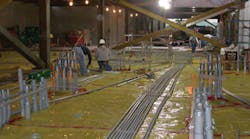High school students will learn about engineering, design, and green technology both inside and outside the classroom at the $66 million Science Park High School in Newark, N.J. The high school, which is being built with funds from the state's $8.6 billion school capital construction program, will serve as a living laboratory for 1,200 students. Electricians will install a 32kW rooftop photovoltaic system, which will generate enough power to light one of the classrooms, and a geothermal heating and cooling system will vent air through a supply-and-return network.
Science Park, the first high school to be built in Newark, N.J., in four decades, will help to fulfill the city's mission of revitalizing its neighborhoods and increasing enrollment in New Jersey colleges and universities. Four local colleges and universities — Essex County Community College, the New Jersey Institute of Technology, Rutgers State University-Newark, and the University of Medicine and Dentistry of New Jersey — developed a partnership to plan and design Science Park High School in 1998, and work began five years later. The construction crew is building the 290,150-square-foot high school in the heart of the University Heights Science Park. The park will eventually include one million square feet of technology laboratories and offices, 20,000 square feet of retail space, two blocks of housing, and the new high school.
RCC Electric, a Paterson, N.J.-based electrical contracting firm, has a $6.4 million contract to install the electrical, datacom, security, and lighting systems throughout the three-story building. The contractor will be responsible for the power distribution and power branch circuits; fire alarm system; clock system; public address and paging systems; audio visual network system for classrooms; auditorium and music room sound systems; photovoltaic system; lightning protection; and security access and CCTV systems. The electricians will also illuminate both the high school and the adjacent softball field.
Science Park's design calls for large classrooms with cable and data connections for computers as well as individual workstations. The school will also feature a media and technology center, a long-distance learning system, a fabrication room for robotics, and an independent science research area. The northern section of the building will be devoted to the laboratories, while the southern end will include the natatorium, gymnasium, and theater.
The school's security system features closed-circuit televisions, card access readers, and magnetic security locks. The magnetic door locks are tied into the fire alarm system, which interacts with the school's public address system. The doors are secured while school is in session, but authorized personnel can enter using access cards. Such a state-of-the-art security and communications system is becoming more common for new high schools, says Lincoln Heffner, project manager for Indianapolis-based Hunt Construction Group.
Because the high school is being constructed in the existing Science Park region, the construction team faces the challenge of space constraints on the jobsite. While the building footprint measures 600 feet by 160 feet, the site only measures 700 feet by 250 feet, which leaves little room for jobsite trailers and storage and delivery of materials. David Pappicco, project manager for RCC Electric, says that while working in Newark, N.J., is similar to working in New York City, an even bigger challenge has been to coordinate the electrical work with the mechanical installations in the space allotted for the mechanical/electrical/plumbing equipment within the building.
Adding to the complexity of the project, the construction team is working under a fast-track schedule. Design changes and unusually cold weather have placed constraints on both the budget and the construction team to meet the deadline. The electricians are currently working on roughing in their systems and will install the photovoltaic systems later this summer. Final completion is slated for April 2006 to allow the high school to open in the fall of that year.
“The structure is still being erected, so we have less than 12 months to do the installation,” Pappicco says. “We have to plan in great detail to minimize lost time due to the amount of interfacing between the systems and with the other trades.”
Electrical By the Numbers
- Two 4,000A electrical systems feed the building.
- Eight rooftop solar panels will generate 32kW of power, which is enough to light one of the classrooms.
- About 25 to 30 electricians will be working on the project during the peak of construction.



